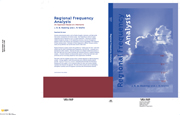Book contents
- Frontmatter
- Contents
- Preface
- Errata
- Chapter 1 Regional frequency analysis
- Chapter 2 L-moments
- Chapter 3 Screening the data
- Chapter 4 Identification of homogeneous regions
- Chapter 5 Choice of a frequency distribution
- Chapter 6 Estimation of the frequency distribution
- Chapter 7 Performance of the regional L-moment algorithm
- Chapter 8 Other topics
- Chapter 9 Examples
- Appendix: L-moments for some specific distributions
- References
- Index of notation
- Author index
- Subject index
Chapter 4 - Identification of homogeneous regions
Published online by Cambridge University Press: 30 October 2009
- Frontmatter
- Contents
- Preface
- Errata
- Chapter 1 Regional frequency analysis
- Chapter 2 L-moments
- Chapter 3 Screening the data
- Chapter 4 Identification of homogeneous regions
- Chapter 5 Choice of a frequency distribution
- Chapter 6 Estimation of the frequency distribution
- Chapter 7 Performance of the regional L-moment algorithm
- Chapter 8 Other topics
- Chapter 9 Examples
- Appendix: L-moments for some specific distributions
- References
- Index of notation
- Author index
- Subject index
Summary
Methods of forming regions
General considerations
Of all the stages in a regional frequency analysis involving many sites, the identification of homogeneous regions is usually the most difficult and requires the greatest amount of subjective judgement. The aim is to form groups of sites that approximately satisfy the homogeneity condition, that the sites' frequency distributions are identical apart from a site specific scale factor. This is usually achieved by partitioning the sites into disjoint groups. An alternative approach is to define for each site of interest a region containing those sites whose data can advantageously be used in the estimation of the frequency distribution at the site of interest. This is the basis of the “region of influence” approach to the formation of regions, discussed in Section 8.1.
Which data to use?
Formation of regions is difficult because the at-site frequency distribution of the quantity of interest, Q, is not observed directly. The available data for region formation are quantities calculated from the at-site measurements of Q, which we call at-site statistics, and other site descriptors that we call site characteristics. In environmental applications the site characteristics would typically include the geographical location of the site, its elevation, and other physical properties associated with the site. Other site characteristics may be based on estimates rather than direct measurements, but are sufficiently accurate to be treated as though they were deterministic quantities.
- Type
- Chapter
- Information
- Regional Frequency AnalysisAn Approach Based on L-Moments, pp. 54 - 72Publisher: Cambridge University PressPrint publication year: 1997
- 1
- Cited by



